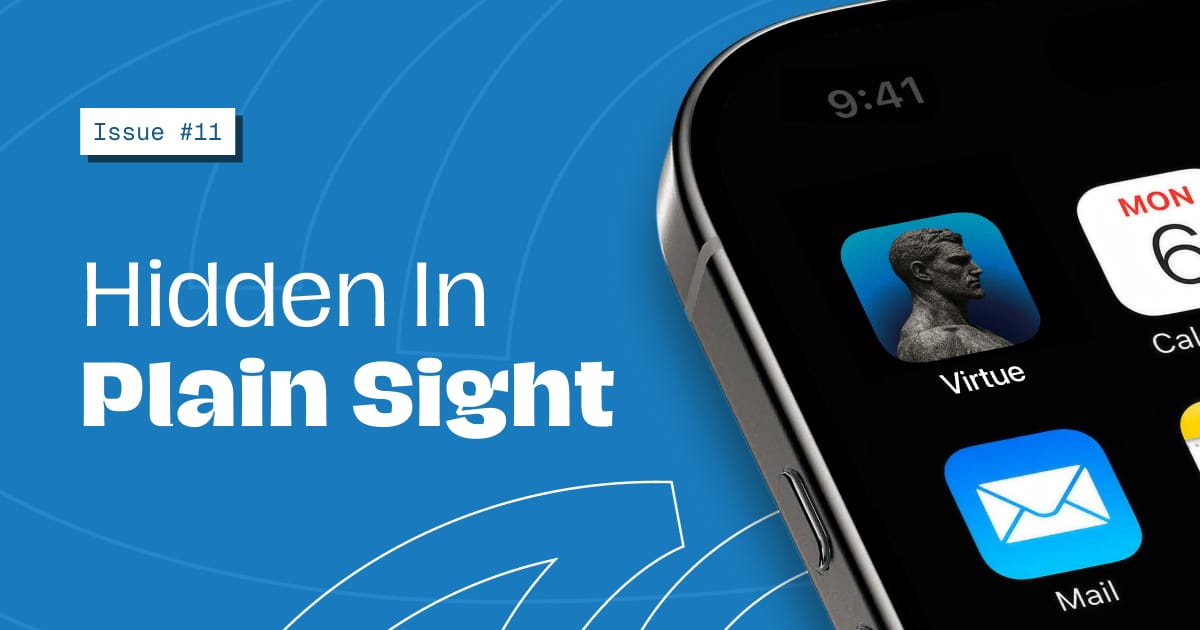
Your App Store Metrics Are Lying to You
Here's what we discovered while building Virtue: Most teams obsess over download numbers while ignoring the compound growth levers Apple baked right into iOS.
We're talking about 15+ native features that can double retention, triple engagement, and actually make acquisition sustainable. Features that 99% of apps either ignore completely or implement so poorly they might as well not exist.
This week, we're pulling back the curtain on the iOS growth playbook we've been refining—and testing whether we can scale this kind of technical knowledge through AI workflows.
The $0 Growth Stack Apple Already Built for You
Last week, Alan spent three days reorganizing our internal iOS documentation. What emerged wasn't just another "implement widgets" checklist. It was a systematic framework for compound growth.
The revelation: Apple has essentially pre-built your entire growth stack. You just need to know where to look and — more importantly — how to measure.
Take App Clips. Most teams see them as "mini apps." Wrong. They're instant conversion machines when built for one perfect action. Our data shows properly implemented App Clips hit 25% interaction rates and 15% full app installs. But here's the kicker—most teams never even track these metrics.
Or Spotlight integration. Not just making your content searchable, but understanding that 5% of your most engaged users will re-enter through system search. Miss this, and you're literally hiding from your power users.
📊 Quick Poll: Should we release the full iOS Growth Levers Playbook?
Why Widget Users Stay 15% Longer (And It's Not What You Think)
The common wisdom about widgets is backwards. Teams stuff them with content, treating them like tiny billboards.
But the apps that win use widgets as behavioral anchors. Fresh, glanceable, actionable. The goal isn't to display information—it's to prevent users from ever fully leaving your ecosystem.
Our research found widget users show 15% higher retention not because they see more content, but because they never experience true app exit. The widget maintains presence even when the app doesn't.
This principle extends across all retention levers:
HealthKit Integration: Reduces input friction, reinforces progress
Watch Apps: Creates new surface area for core actions
Strategic Review Prompts: Timed after success moments, not random intervals
Each lever includes specific metrics and error tracking. Because implementing without measuring is just expensive hope.
The Expertise Scaling Problem
Here's where things get interesting.
We've spent months building this iOS expertise. Testing, measuring, documenting. The playbook alone represents hundreds (if not thousands) of hours of implementation experience.
But how do you scale expertise? How do you help teams implement these strategies without spending months learning the hard way?
This led us to an experiment: What if we could encode our research and implementation knowledge into reusable AI workflows?
Not generic templates. Not "ChatGPT prompts for growth." But structured workflows that produce implementation guides as detailed as what we create manually.
Testing the AI Workflow Hypothesis
The concept is simple. You provide:
Your app's core value proposition
Target audience details
Current metrics baseline
Platform constraints
The workflow produces:
Prioritized implementation roadmap
Technical specifications with code samples
Analytics setup with specific KPIs
Error tracking requirements
Timeline and resource estimates
Same depth we put into our manual guides. Same attention to measurement. Same focus on compound growth over quick wins.
The $1M question: Would you invest in a workflow that produces implementation guides this detailed?
Look, we've all been burned by AI tools that overpromise. That's why we're building a prototype first. But before we go deeper—hit reply and tell me:
What's your biggest frustration with current AI tools?
Would you actually use something like this?
I read every reply. Even the brutal ones.
This Week's Deep Dive: Acquisition Levers That Actually Convert
While we test demand for the AI workflow, here's a preview of three acquisition levers from our playbook:
Custom Product Pages: Different Doors for Different Visitors
Create up to 35 unique landing experiences
Customize based on traffic source and user intent
Track conversion lift by source (target: >5%)
Monitor bounce rates (<40% is your guardrail)
App Store Metadata: Your SEO, But for Apple
A/B test beyond screenshots—title, subtitle, keywords matter
Optimize for scroll-stopping clarity
Track keyword-level conversions
Maintain <10% conversion variance
In-App Events: Give Them a Reason to Return Today
Surface live content directly on the App Store
Create urgency with time-limited value
Measure 7-day retention lift (>3% target)
Watch post-event churn (<30% acceptable)
Notice the pattern? Every lever ties to specific metrics. Implementation without measurement is just wishful thinking.
What We're Building vs What We're Testing
Virtue Progress: Deep in the polish phase. Those micro-interactions we obsessed over? Starting to feel less like software and more like craftsmanship. The habit completion now has weight to it, like carving your character in stone rather than tapping glass.
AI Workflow Experiment: Building a prototype this week. If our own workflow can produce guides we'd stake our reputation on, we'll open it up for testing.
The Bigger Picture: We're betting that the future isn't AI replacing expertise—it's AI scaling expertise. Making deep technical knowledge accessible without dumbing it down.
Your Move
We genuinely want to know: Does the AI workflow concept solve a real problem for you? Or are we solving for ourselves?
Hit reply with your thoughts. Especially if you've tried other AI tools and been burned.
And if enough of you vote "yes" on the iOS playbook poll above, we'll package it up and send it out next week. No strings, no upsells…just the complete implementation guide.
Next week: Virtue launch prep, AI workflow results, and whatever rabbit hole we fall down between now and Tuesday.
Talk to you all next week,
Colin, Alan, & David
P.S. Speaking of iOS growth levers—if you're reading this on iPhone, long-press the Messages app icon. See those quick actions? That's just one of the 15 levers most apps ignore. We'll show you the other 14.
